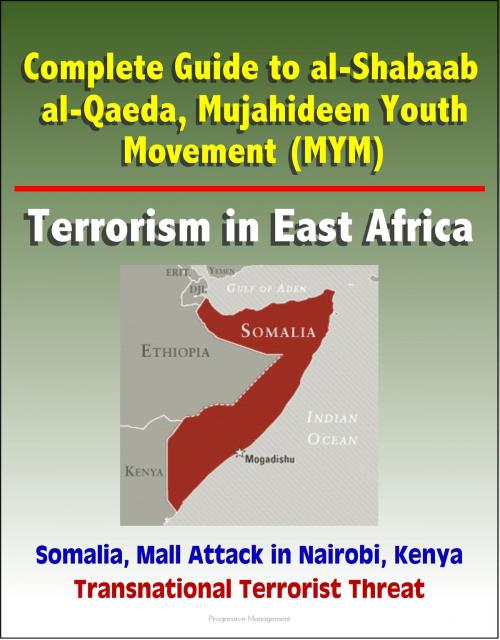Complete Guide to al-Shabaab, al-Qaeda, Mujahideen Youth Movement (MYM), Terrorism in East Africa, Somalia, Mall Attack in Nairobi, Kenya, Transnational Terrorist Threat
Nonfiction, Social & Cultural Studies, Political Science| Author: | Progressive Management | ISBN: | 9781301621255 |
| Publisher: | Progressive Management | Publication: | September 23, 2013 |
| Imprint: | Smashwords Edition | Language: | English |
| Author: | Progressive Management |
| ISBN: | 9781301621255 |
| Publisher: | Progressive Management |
| Publication: | September 23, 2013 |
| Imprint: | Smashwords Edition |
| Language: | English |
This unique ebook provides a thorough review of all aspects of the threat posed by terrorists from East Africa, focusing on the al-Shabaab group (also known as the Mujahideen Youth Movement MYM). These al-Qaeda affiliated terrorists claimed responsibility for the brutal assault on the Westgate Shopping Mall in Nairobi, Kenya on September 21, 2013.
Contents: Part 1: Overview * Part 2: Somalia: Line in the Sand — Identification Of MYM Vulnerabilities * Part 3: Senate Hearings, Violent Islamist Extremism: Al-Shabaab Recruitment in America * Part 4: House Hearings, The Extent of Radicalization in the American Muslim Community and that Community's Response * Part 5: Countering Terrorism in East Africa: The U.S. Response
The Harakat Shabaab al-Mujahidin—also known as al-Shabaab, Shabaab, the Youth, Mujahidin al-Shabaab Movement, Mujahideen Youth Movement, and many other names and variations—was the militant wing of the Somali Council of Islamic Courts that took over most of southern Somalia in the second half of 2006. Although the Somali government and Ethiopian forces defeated the group in a two-week war between December 2006 and January 2007, al-Shabaab—a clan-based insurgent and terrorist group—has continued its violent insurgency in southern and central Somalia. The group has exerted temporary and, at times, sustained control over strategic locations in those areas by recruiting, sometimes forcibly, regional sub-clans and their militias, using guerrilla warfare and terrorist tactics against the Transitional Federal Government (TFG) of Somalia and its allies, African Union Mission in Somalia (AMISOM) peacekeepers, and nongovernmental aid organizations. However, the group’s insurgency has been challenged over the past year by in-fighting and military pressure that has liberated key towns from al-Shabaab.
Al-Shabaab is not centralized or monolithic in its agenda or goals. Its rank-and-file members come from disparate clans, and the group is susceptible to clan politics, internal divisions, and shifting alliances. Most of its fighters are predominantly interested in the nationalistic battle against the TFG and not supportive of global jihad. Al-Shabaab’s senior leadership is affiliated with al-Qa‘ida and is believed to have trained and fought in Afghanistan. The merger of the two groups was publicly announced in February 2012 by the al-Shabaab amir and Ayman al-Zawahiri, leader of al-Qa‘ida.
Al-Shabaab has claimed responsibility for many bombings—including various types of suicide attacks—in Mogadishu and in central and northern Somalia, typically targeting Somali government officials, AMISOM, and perceived allies of the TFG. The group was likely responsible for a wave of five coordinated suicide car bombings in October 2008 that simultaneously hit targets in two cities in northern Somalia, killing at least 26 people, including five bombers, and injuring 29 others. Al-Shabaab also claimed responsibility for the twin suicide bombings in Kampala, Uganda, on 11 July 2010 that killed more than 70 people. Al-Shabaab’s leaders also have ordered their fighters—which include Americans and other Westerners—to attack African Union peace-keeping troops based in Mogadishu. Al-Shabaab is responsible for the assassination of Somali peace activists, international aid workers, numerous civil society figures, and journalists. The group gained additional notoriety by blocking the delivery of aid from some Western relief agencies during the 2011 famine that killed tens of thousands of Somalis.
This unique ebook provides a thorough review of all aspects of the threat posed by terrorists from East Africa, focusing on the al-Shabaab group (also known as the Mujahideen Youth Movement MYM). These al-Qaeda affiliated terrorists claimed responsibility for the brutal assault on the Westgate Shopping Mall in Nairobi, Kenya on September 21, 2013.
Contents: Part 1: Overview * Part 2: Somalia: Line in the Sand — Identification Of MYM Vulnerabilities * Part 3: Senate Hearings, Violent Islamist Extremism: Al-Shabaab Recruitment in America * Part 4: House Hearings, The Extent of Radicalization in the American Muslim Community and that Community's Response * Part 5: Countering Terrorism in East Africa: The U.S. Response
The Harakat Shabaab al-Mujahidin—also known as al-Shabaab, Shabaab, the Youth, Mujahidin al-Shabaab Movement, Mujahideen Youth Movement, and many other names and variations—was the militant wing of the Somali Council of Islamic Courts that took over most of southern Somalia in the second half of 2006. Although the Somali government and Ethiopian forces defeated the group in a two-week war between December 2006 and January 2007, al-Shabaab—a clan-based insurgent and terrorist group—has continued its violent insurgency in southern and central Somalia. The group has exerted temporary and, at times, sustained control over strategic locations in those areas by recruiting, sometimes forcibly, regional sub-clans and their militias, using guerrilla warfare and terrorist tactics against the Transitional Federal Government (TFG) of Somalia and its allies, African Union Mission in Somalia (AMISOM) peacekeepers, and nongovernmental aid organizations. However, the group’s insurgency has been challenged over the past year by in-fighting and military pressure that has liberated key towns from al-Shabaab.
Al-Shabaab is not centralized or monolithic in its agenda or goals. Its rank-and-file members come from disparate clans, and the group is susceptible to clan politics, internal divisions, and shifting alliances. Most of its fighters are predominantly interested in the nationalistic battle against the TFG and not supportive of global jihad. Al-Shabaab’s senior leadership is affiliated with al-Qa‘ida and is believed to have trained and fought in Afghanistan. The merger of the two groups was publicly announced in February 2012 by the al-Shabaab amir and Ayman al-Zawahiri, leader of al-Qa‘ida.
Al-Shabaab has claimed responsibility for many bombings—including various types of suicide attacks—in Mogadishu and in central and northern Somalia, typically targeting Somali government officials, AMISOM, and perceived allies of the TFG. The group was likely responsible for a wave of five coordinated suicide car bombings in October 2008 that simultaneously hit targets in two cities in northern Somalia, killing at least 26 people, including five bombers, and injuring 29 others. Al-Shabaab also claimed responsibility for the twin suicide bombings in Kampala, Uganda, on 11 July 2010 that killed more than 70 people. Al-Shabaab’s leaders also have ordered their fighters—which include Americans and other Westerners—to attack African Union peace-keeping troops based in Mogadishu. Al-Shabaab is responsible for the assassination of Somali peace activists, international aid workers, numerous civil society figures, and journalists. The group gained additional notoriety by blocking the delivery of aid from some Western relief agencies during the 2011 famine that killed tens of thousands of Somalis.















